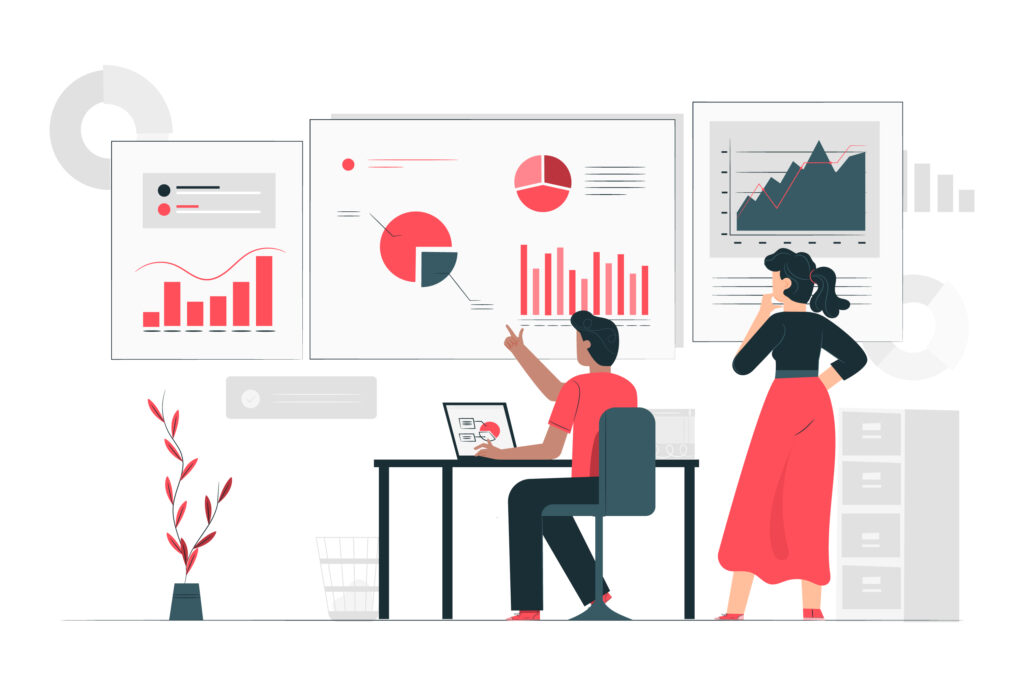Simply learning employee information is not enough; performance appraisals and the like provide a limited view of what the employee can achieve and their potential. To make the most out of employee information, it is important to account for cross-functional data that not only reflects what the employee is doing but also their business goals. This is addressed with the help of people analytics.

As per research conducted by SHRM, 94% of those holding leadership roles admit that people analytics has the scope to improve HR functions. However, not all of them (only 71%) actually use people analytics in jobs to streamline their HR strategy.
Let’s take a look at what people analytics is, how it impacts HR functions, and what people analytics software can achieve.
What is People Analytics and What Does it Mean for Organisations?
People Analytics is a system that uses data and statistics taken from various business processes to provide insights into each aspect of the business and its workforce. By providing information on multiple functional areas, people analytics helps businesses make the most of their workforce and reach all critical business outcomes.
In terms of an HR system, people analytics rests on the following foundations:
- Workforce planning
- Talent sourcing
- Talent acquisition
- Onboarding and engagement
- Performance management
- Talent attrition and retention
- Employee wellness, health, and safety
People analytics help provide insights on the following:
- HRIS Data, such as recruitments, L&D programs, succession planning, and employee feedback.
- Additional HR Data regarding employee demographics, job roles, etc.
- Business Data, like performance analytics, compensation details, and exit interviews.
- CRM and sales data
- Financial information
- Production management data
People Analytics vs HR Analytics
Often used in lieu of the other by HR professionals, people analytics and HR analytics imply two very different metrics, accounting for different parameters.
To understand them better, people analytics and HR analytics can be compared with the help of a table:
| Features | People Analytics | HR Analytics |
| Scope | Cross-functional data | HR specific data |
| Perspective | Based on business and workforce trends | Checks historical data for an employee |
| Purpose | Making strategic decisions vis-à-vis the staff | Improving HR processes |
| Sources of Data | Data from all business processes, including HRIS, finance, marketing, etc. | Data and analytics from HR systems |
| Metrics | Employee engagement Market information Customer feedback Sales performance | Employee turnover rate Time to hire Absenteeism Performance ratings |
| Overlap | May overlap with HR metrics | May overlap with workforce analytics |
Table 1: People analytics vs HR Analytics
Benefits of People Analytics
When businesses utilise people analytics, they stand to enjoy a range of benefits. With people analytics, jobs and how they meet organisational needs become easy to manage and understand. Further, the primary benefits include:
Practicing Data-Driven Decision Making
People analytics software makes employee data easily available alongside analytics. This helps remove the scope for bias, fix inconsistencies, and enable data-driven decisions.
Using HR Intervention to Streamline Business Strategy
To keep up with the competitors and remain profitable, every business needs to achieve certain goals. By accounting for both employee metrics and business goals, people analytics can help align both, ensuring that the business is able to meet all milestones early.
Improving Organisational and Employee Performance
People analytics often contain data on collaborative work, employee workload, workplace risk assessments, and more. Taking suitable action based on this data can improve employee performance, which in turn will help the business improve its performance as a whole.
Ensuring Cost Savings
People analytics can shed light on areas that need more attention and ones that don’t. This helps redistribute the budget and save on investing in areas that do not need an investment. Further, identify employees who are suitable for promotions, reduce turnover, and improve quality-per-hire, thus reducing the costs of hiring.
Reducing Employee Turnover
People analytics can elaborate on why employees are leaving your organisation, what your attrition and retention rates are, and even employees who are more likely to leave. This helps create targeted strategies to address retention.
Bridging Talent Gaps
Skill gaps among workers not only reduce efficiency but also reduce engagement. Further, upskilling new employees and promoting them to better roles can drive employee engagement. People analytics helps shed light on the skills an employee has and what they need to perform better in their role, and become eligible for promotions.
Improving Recruitment
When HR makes data-driven decisions during recruitment, they can cut back on employee attrition by half with an 80% increase in recruitment efficiency. This also ensures that only the best-suited people for a role are hired and can even reduce the cost per hire.
4 Stages of People Analytics
Based on the insights they offer, people analytics can be classified into the following types:
Descriptive Analytics
The most popular form of people analytics (used by 83% of organisations), descriptive analytics assesses historical data and provides statistical insights. However, it does not give any idea of trends and challenges that the organisation may observe in the future or ways to address these.
Diagnostic Analytics
To account for the results of descriptive analytics, descriptive analytics offers insights on why certain data, trends, and correlations are observed.
Predictive Analytics
This function accounts for past and current data to predict what may occur in the future and trends that might be seen. However, predictive analysis is rarely used, being observed in only 20% of all organisations.
Prescriptive Analytics
Built on the foundation of predictive analytics, prescriptive analytics adopts suggestions based on future predictions to make better decisions. While a useful tool, only 17% of businesses use prescriptive analytics.
Choosing the Right People Analytics Software
People analytics is a comprehensive exercise, and something that cannot be addressed manually or with the help of spreadsheets. This makes it essential to have a suitable system to take up the task, i.e., a well-designed people analytics software.
Key Features to Look for
At its core, the people analytics software should be able to address your organisation’s needs. Further, it should offer the following features:
- Integration with existing systems
- User-friendly interface
- Easy to interpret analytics and dashboards
- Scalability to handle all workforce growth
- Easy customisation to address organisational needs
- Actionable insights to improve decision making
CIPD’s Role in Shaping People Analytics
According to CIPD, people analytics should meet the following three aims:
- Connect people data to business data for better decision making.
- Enable the use of analytic insights for targeted activities.
- Measuring the effectiveness and impact of targets delivered.
Thus, with CIPD, people analytics can be useful for the following:
- Promoting evidence-based and data-driven HR practices.
- Offer guides and resources to help capture data, understand analytics, and implement changes.
- Using predictive analytics to identify all potential trends and challenges.
- Bridge the gap between people data and business data.
- Measuring the effectiveness of the HR and business processes.
- Aligning workforce strategy to business goals.
Building a Data-driven HR Mindset
Though many recognise its importance, recent data shows that just 67% of HR officials rely on HR and people analytics to ensure data-driven decisions. These are realised in terms of the following:
Essential HR Metrics for Analytics
Cost-per-hire, retention, productivity, engagement, absenteeism, and turnover are the most basic HR metrics. Combined with performance appraisals, these make up the basic analytics that an organisation needs to account for.
How to Turn Data Into Action
Based on the analytics obtained from the above parameters, business leaders need to make a decision to implement measures that drive business goals and performance. The people analytics software in question should be able to address these requirements.
Creating a Culture of People Analytics
Using the analytics obtained, the leadership can lay out the business goals and objectives and identify areas where the organisation is falling behind. This also helps facilitate better data governance and data-driven decision making.
Training Your HR Team
Lastly, it is important to train the team, especially HR, to use the people analytics software. Once the team is trained, deploying the system and obtaining stakeholder buy-in becomes easy.
Ethical Considerations in Employee Data Use
Maintaining fair practices and balancing employee and organisational privacy is key when opting for people analytics software. When using people analytics, these are the key ethical considerations to keep in mind:
- Data Privacy and preventing unauthorised access.
- Obtaining consent and maintaining transparency regarding data use.
- Having robust data security measures.
- Collecting only necessary information.
- Preventing discrimination based on collected employee data.
- Ensuring the data collected is accurate and reliable.
- Adherence to industry norms alongside legal requirements.
- Establishing proper data governance guidelines.
- Using the data collected only for legitimate purposes, for which consent has been obtained from employees.
Getting Started With People Analytics
Once you have decided to use people analytics and have the software ready to go, here’s how to get started:
Setting Objectives and KPIs
Check the parameters offered by the people analytics software for key objectives and KPIs necessary for your organisation. Then, customise the platform to meet your business needs by setting the indicators against each parameter that you need to observe.
Integrating Analytics Into Decision-making
Based on the objectives set, people analytics platforms are designed to offer analysis on employee data. These indicate areas where the business is performing well and where it can face challenges. Then, the leadership can take data-driven decisions, allocating more resources in necessary areas.
Common Pitfalls to Avoid
No software tool is immune to drawbacks, and people analytics is not an exception. Here are some pitfalls that you need to steer clear of:
- Lack of clarity in the objectives set
- Using poor quality or inaccurate data
- Not respecting employee privacy
- Failing to use the analytics obtained in strategising
- Failing to align the objectives with business goals
- Relying heavily on past data
What’s Next? Future Trends in People Analytics
Using people analytics software to gather and analyse employee and business data is just the start. With rapid innovations, the following are expected to lead the way in people analytics.
Predictive Analytics in HR
Currently, only a small portion of businesses are opting for predictive analytics. However, this can help address issues before they occur with suitable pre-emptive measures.
Role of AI and Machine Learning
Using continuous inputs from users, AI-driven systems are designed to improve the user experience and functionality, which in turn can streamline the system. It can automate tasks, offer timely insights, and create more targeted plans. Further, these can help predict trends with more accuracy than current systems.
Privacy, Bias, and the Ethics of HR Tech
The primary ethical concern is always having a system that ensures privacy and offers bias-free results. Further, better provisions can be made for data security, privacy, and transparency with a better people analytics software.
Wrapping Up: Decision Making With People Analytics
People analytics is an efficient way to manage and analyse data to get the most out of your workforce and align targets to business goals. This facilitates better decision-making and resource allocation, ensuring the organisation is ready to counter most, if not all, business challenges.
Ready to harness employee data to drive your business? Evaluate people analytics software for your workplace today!
Frequently Asked Questions
Can People Analytics Affect Performance Management?
People analytics can install a data-driven system that removes the bias from appraisals. It also helps identify high performers and skill gaps, facilitating L&D systems.
Do People Analytics Software Offer a Way to Help With L&D Programs?
People analytics software can not only check for skill gaps among employees but also predict which skills are going to be in demand with the change in business trends. Thus, it becomes easier to design suitable L&D programs and allocate resources accordingly.
Is People Analytics the Same as Workforce Analytics?
Though similar, they are not identical. Workforce analysis is done for just the staff, while people analysis also accounts for the customers and their experience with the organisation.
Will People Analytics Help Keep Employee Attrition and Turnover in Check?
People analytics can help identify which workers are at risk of leaving the organisation, thus helping HRMs to create targeted retention plans.
Which Data Are Useful for People Analytics Software?
Employee demographics, recruitment data, performance analytics, engagement surveys, productivity data, exit interviews, and more can act as sources of input for the people analytics software.





